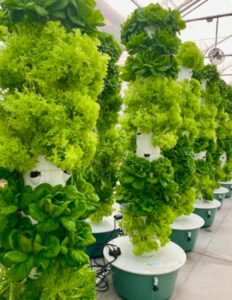Are you interested in sustainable agriculture practices that maximize yield and minimize resource usage? Look no further than an aeroponic tower, a cutting-edge technology that is revolutionizing urban agriculture. In this article, we will explore the concept of aeroponic towers, their benefits, and their potential to transform food production in urban settings. Join us as we delve into this innovative farming method and uncover its immense potential.

Understanding Aeroponics
Aeroponics, a subset of hydroponics, is a soil-less farming technique that involves growing plants in an air or mist environment, with the roots suspended in the air. In contrast to conventional soil-based farming, aeroponics eliminates the requirement for soil, enabling plants to receive nutrients and water directly through their root systems.
This unique method provides plants with optimal oxygen levels, leading to faster growth rates and higher yields.
The Concept of Aeroponic Towers
Aeroponic towers take the principles of aeroponics to new heights, quite literally. These vertical structures consist of multiple stacked levels, each housing numerous plants. The tower design allows for efficient use of space, making it ideal for urban environments with limited land availability. By utilizing vertical space, aeroponic towers enable the cultivation of a large number of plants within a small footprint, making them an excellent solution for urban farming.
Advantages of Aeroponic Towers
- Increased Crop Yield
One of the primary benefits of aeroponic towers is their ability to maximize crop yield. The controlled environment provided by the towers ensures optimal growing conditions for plants, resulting in faster growth and larger harvests. With aeroponics, farmers can achieve higher crop yields compared to traditional farming methods.
- Water Efficiency
Water scarcity is a significant concern in many regions worldwide. Aeroponic towers offer an efficient solution to this problem. By delivering nutrients and water directly to the plant roots in a mist form, aeroponics reduces water usage by up to 95% compared to conventional farming. This water-saving feature makes aeroponic towers an environmentally friendly and sustainable choice.
- Space Optimization
As mentioned earlier, aeroponic towers are designed to make the most of limited space. By employing vertical stacking, these towers allow farmers to cultivate a substantial quantity of plants in a limited space. This efficient utilization of space is particularly advantageous in urban regions where land is both scarce and costly. Aeroponic towers allow for efficient use of available space, making urban farming economically viable.
- Pest and Disease Control
Aeroponic towers provide an added advantage in pest and disease control. Since the plants are grown in a controlled environment, the risk of infestation and disease transmission is significantly reduced. The absence of soil eliminates the potential for soil-borne pests, and the vertical arrangement of the towers helps maintain airflow, preventing the buildup of humidity and minimizing the risk of fungal infections. This translates to healthier plants and lower reliance on chemical pesticides.
- Overcoming Challenges
While aeroponic towers offer numerous advantages, they also come with their own set of challenges. The initial setup cost can be higher compared to traditional farming methods. Additionally, the technology requires a precise balance of environmental factors such as temperature, humidity, and nutrient levels. Adequate training and monitoring are essential to ensure optimal conditions for plant growth. However, with advancements in technology and increased adoption, these challenges can be overcome, making aeroponic towers a viable and promising solution for urban agriculture.
Disadvantages of Aeroponic Towers:
- High initial cost: Aeroponic towers require specialized equipment, such as misting systems and nutrient delivery mechanisms, which can be expensive to set up initially. This cost can be a barrier for small-scale farmers or those with limited financial resources.
- Technical complexity: Aeroponic systems can be complex to set up and maintain. They require precise control of environmental factors such as temperature, humidity, and nutrient levels. Monitoring and adjusting these parameters can be challenging and time-consuming.
- Vulnerability to power outages: Aeroponic systems heavily rely on electricity to power pumps, misters, and timers. In the event of a power outage, the plants may be left without the necessary nutrient mist and could suffer from dehydration or nutrient deficiencies.
- Risk of system failure: The high level of technical complexity in aeroponic systems increases the risk of system failures. Malfunctioning misters, clogged nutrient lines, or imbalances in nutrient delivery can lead to plant stress or crop losses if not promptly addressed.
- Sensitivity to environmental conditions: Aeroponic towers are sensitive to changes in environmental conditions, such as temperature fluctuations or variations in humidity levels. Extreme weather events or sudden environmental changes can impact plant health and productivity.
- Limited crop selection: Not all crops thrive in aeroponic systems. Some plants may have difficulty adapting to the high oxygen and moisture levels in the root zone or may require specific soil conditions that are not easily replicated in an aeroponic setup. This limitation restricts the range of crops that can be grown using this method.
Conclusion
In conclusion, aeroponic towers present a game-changing approach to urban agriculture. With their ability to maximize crop yield, conserve water, optimize space, and provide effective pest and disease control, these towers are poised to transform the way we grow food in cities. By harnessing the power of aeroponics, farmers can cultivate a wide variety of crops in a sustainable and resource-efficient manner. As the world grapples with the challenges of feeding a growing population, aeroponic towers as well as a hydroponic shipping container farm offers a glimpse into a future where fresh, locally grown produce is readily available in urban centers. Embrace the potential of aeroponic towers and join the movement toward a greener, more self-sufficient world.
